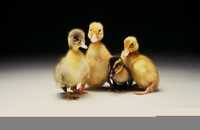Friday, March 11, 2011
Modern hatcheries are now adopting the ways of Mother Nature. Only one age of eggs are put in an incubator – just like a hen sitting on eggs in a nest is sitting on only one age of eggs. This is a radical change as the tradition for the past 100 years has been to have multiple ages of eggs in one incubator. If you set duck eggs once a week, for example, you will have some eggs less than one week, some less than two weeks, some less than three weeks and some less than four weeks. This was done so the heat generated by the older eggs was helping heat the younger eggs.

Temperature: But it has now been learned that by filling an incubator with only one age of eggs, you can provide a much better environment for their development. Instead of providing a steady temperature of 99.5 degrees for the entire incubation, you can start at a warmer temperature (100.3 for our duck eggs) and gradually drop down to a much lower temperature at hatching (97.0 for duck eggs).
Carbon Dioxide: To me, the most interesting change with Single Stage Incubation is that carbon dioxide levels are considered very important – and the higher the better at certain points! The air you are breathing right now is about 300-500 parts per million (ppm) of carbon dioxide. For single state incubation, all vents are closed the first 14 days and levels of up to 8000 ppm are desirable!
Carbon Dioxide: To me, the most interesting change with Single Stage Incubation is that carbon dioxide levels are considered very important – and the higher the better at certain points! The air you are breathing right now is about 300-500 parts per million (ppm) of carbon dioxide. For single state incubation, all vents are closed the first 14 days and levels of up to 8000 ppm are desirable!

Consequences: With our new Jamesway incubators installed the spring of 2009, we are experiencing improved hatches of 2-15% of fertile eggs! In addition, the birds are slightly heavier at hatch (less weight is lost during incubation) and they hatch within a smaller “hatch window”. This allows us to mail a slightly heavier bird that has hatched more recently.
What does this mean to you? This means you can probably do single stage incubation in your incubator with your duck and goose eggs! Start with a slightly warmer temperature and then gradually drop it during incubation. Close all vents the first 14 days then gradually open them. Toward the end of incubation (days 22-28) you will need the vents more open than if you have multiple ages in the incubator as all the eggs will be generating extra heat.
For more detailed information on Single Stage Incubation and how you might be able to use the concepts for your incubation, please visit our website at www.metzerfarms.com/Articles/SingleStageIncubation.pdf
What does this mean to you? This means you can probably do single stage incubation in your incubator with your duck and goose eggs! Start with a slightly warmer temperature and then gradually drop it during incubation. Close all vents the first 14 days then gradually open them. Toward the end of incubation (days 22-28) you will need the vents more open than if you have multiple ages in the incubator as all the eggs will be generating extra heat.
For more detailed information on Single Stage Incubation and how you might be able to use the concepts for your incubation, please visit our website at www.metzerfarms.com/Articles/SingleStageIncubation.pdf